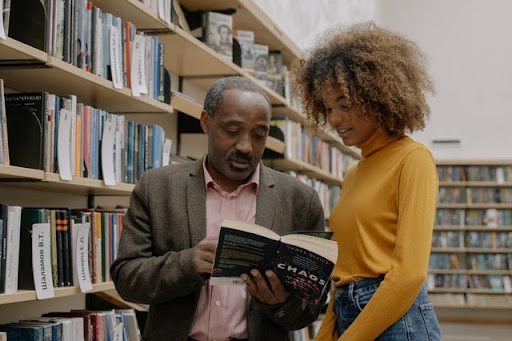As academic librarians, we are going into the Fall semester still navigating the COVID-19 pandemic. We and many of our students have gone through additional traumatic events this past year and a half. In this blog post, I will interview Nisha Mody, feminist healing coach, writer, and librarian, to help us be trauma-informed this semester and beyond.
Jamia: How can being trauma-informed help us with our interactions with students?
Nisha: Being trauma-informed acknowledges how trauma can deeply affect everyone, which is informed by systemic and personal trauma. Students come into educational settings with their whole selves, as do we all. They might have childhood trauma, they may have lost a loved one, they might not thrive academically in a traditionally structured school setting, they may have a family member struggling with codependency, or they might be struggling as well. And on top of it, they can be on the receiving end of systemic trauma like racism, sexism, colonization, ableism, fatphobia, and/or transphobia. And this is also something generational.
Oftentimes, we don’t see trauma in people because they seem “fine”—however, our bodies often protect us to appear “fine” in order to survive. Or we don’t talk about it because that helps it go away, too. So being trauma-informed helps you to meet students where they’re at. It sees them as a whole person, not just a student in an institution. It also sees how institutions can be retraumatizing by reinforcing many norms they have experienced their whole life. This is especially true for disabled folks who often don’t receive the ideal accommodations to thrive or access intimacy from their peers.
With COVID, many students had to learn from home (if they were away) and lost physical connection to peers, on top of potentially losing someone they love to COVID or not having access to adequate health care. They have gone through so much during a time in their lives when many hope to create new social connections while their identities continue to evolve and develop. Additionally, some students may have had to return home to a situation that isn’t supportive to their well-being.
So, when we step into the classroom, it’s so important to be cognizant of what we DON’T know. We cannot assume anyone’s well-being or mental health by what we see visibly. This is why being trauma-informed is so essential. We must be sensitive to the whole person and how they aren’t just objects where we deposit information.
Jamia: How can being trauma-informed help us with library instruction?
Nisha: Being trauma-informed means not assuming anything about an individual, offering choices, and being transparent about what you do and do not know. This means being very clear about what you will teach before you teach it, providing as many accommodations as possible, including considering the accessibility of your presentation. It means setting boundaries and expectations for your session. For example, you can talk about how the session will look and when you prefer they ask questions, if they might be required to move during the session, and the boundaries and expectations that the library espouses as well. You can talk about accessibility (or the lack thereof) directly to students, so they aren’t surprised or confused when they get to the library or use the website. I think it’s really important to be transparent about the ways the library can or cannot be accommodating. Being vulnerable (within your capacity) and being a whole person yourself can help create a relationship with students. And, of course, in a time of misinformation, I think instruction is a great opportunity to learn FROM students’ experiences, especially during the pandemic. How are you empowering them to share? What opportunities are you giving them to provide feedback or voice concerns?
Being trauma-informed can also be talking about how the library can be a place for social connection, so they don’t feel alone. Many people associate going to the library with studying, but talking about stressbusters or other not-so-quiet library spaces makes the library feel more inviting. If a student isn’t listening or is disruptive, it’s essential to have compassion and not be punitive toward them—setting boundaries and expectations can help to address this. Also, trauma-informed instruction means caring for yourself. Do you feel regulated enough to teach? Have you grounded yourself before a class starts? Do you have a ritual or practice to ground yourself before teaching, or are you just going back-to-back without allowing space for your own well-being? Human energy is palpable, and people pick up on that, including students. Even modeling regulating strategies like deep breaths, taking a pause for yourself, and giving yourself self-compassion can be beneficial to students. I once told a colleague about a friend of mine who couldn’t laugh without sighing afterward. He actually used this during a class! Sighing is a great regulating strategy for your body, and it provides a way for students to laugh and connect with this information.
If you are in more of an embedded setting, you can really work to develop relationships with the students to show them you care about them as human beings, as opposed to only caring about what they know about the library. Students will likely have less library anxiety if they feel safe in that environment. There are so many ways to be trauma-informed during instruction. It really starts with you as a whole person meeting students as whole people and having regard for what they may have been through in their lives.


See also:
- The Embedded Librarian: Teaching Research and Building Relationships Across the College Campus
- Making the Necessary Adjustments to Teach Virtually: Interview with Ayaba Logan
- Library Instruction & Reflective Practice: Interview with Student Success Librarian Amanda M. Leftwich
- On Remote Work, Engagement, and User Experiences: An Interview with Jamie Lin, Education & Professional Development Manager at Atla
- Wellness and Librarianship: An Interview with Loida Garcia-Febo

